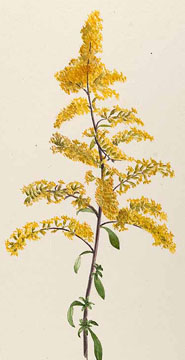 Solidago nemoralis Solidago nemoralisOld Field Goldenrod This magic herb has various connections with money and divination. In English folklore, the flowers of a goldenrod held in the hand were thought to point to springs as well as buried treasure. Some consider a goldenrod bouquet to help in divination, apparently because of the sunny color of the flowers, which act as an illumination (much as with this plant's use as a dowsing rod). Despite the yellow blooms, goldenrod is typically considered a Venus herb, probably because its medicinal use has often been for healing wounds (it contains a lot of tannin) and Venus is associated with the skin. Venus also has monetary connections, which along with the color, explains its use for finding or drawing wealth; some put a few dried blooms in their wallet to draw money, for instance. It is good for drying (the Navajo burned this plant as a ceremonial incense, perhaps in part because the flowers maintain their yellow color) and makes a nice cut flower , especially for harvest celebrations (marking the wealth of the contract between humans and the land). Dried flowers are good in wreaths or as a component in incense for prosperity (combine 1:1 with benzoin). The just-opened flowers make a clear yellow dye on wool; the whole plant makes an olive or mustard dye on wool. Consider this dye for magical items involved in prosperity spells. Goldenrod signifies encouragement and good fortune in the language of flowers. The short stature of this native goldenrod means you can collect the flowers without having to deal with the typically large growth of other goldenrods. Old field goldenrod works well in cottage gardens, rock gardens, and as a groundcover for dry areas. The foliage is more silvery than most goldenrods, which means it's a nice companion for blue or purple flowers. Goldenrod does NOT cause hay fever. It is also known as gray, prairie, grayleaf, gray-leaved, dwarf, field, and dyersweed goldenrod, also as woundwort and coyote plant. How to grow Old Field Goldenrod These seeds need light to germinate and 90 days of cold stratification. You might get some germination just from sprinkling them on moist planting medium and gently pressing them in with your fingertip and misting regularly, but for better germination, use cold stratification either in the fridge or outdoors. Old field goldenrod likes full sun and dryish conditions. It can grow where other plants are unhappy and is a pioneer plant (one of the first that will start growing in a bare area). It gets from 6-24" high. It does not bloom all at once and the flowers appear later in the fall than other goldenrods, both of which are helpful for pollinators. They include all sorts of bees, moths, butterflies, and helpful wasps. Goldfinches will also eat the seeds. This plant will form groups from underground rhizomes when it's happy, but it will also reseed. It can also be reproduced by cuttings with 4-6 leaf nodes taken in the spring. Old field goldenrod is a perennial in temperate areas (zones 4-8), down to -30F/-34C, but won't do well in the Deep South. |
Solidago nemoralis
Uses in Witchcraft & Magic:
Properity Spells © 2016-2024 Alchemy Works;
No reproduction without permission
|